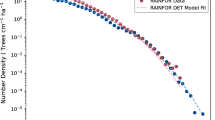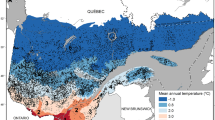Abstract
Vaganov and Hughes reply— The model we used, which is driven only by meteorological variables, reproduces the decadal timescale variations in relative tree-ring width indices that have been observed at three taiga sites in the Siberian subarctic separated by 85 degrees of longitude1. In our study, absolute differences in mean growth rate between sites, related to slowly varying site conditions such as nutrient status, are removed by converting to dimensionless indices with a mean of unity. The results from the fertilization experiment on young plantation spruce trees described by Jarvis and Linder are thus not in disagreement with our major findings.
Similar content being viewed by others
Main
Jarvis and Linder suggest that the effect of soil temperature on the timing of cambial initiation is indirect, rather than direct. We acknowledge that it is not possible to say whether the effects of temperature and moisture are direct or indirect using the methods we adopted, especially for wood increment, which results from a combination of different processes at the whole-tree and tissue levels. We would point out, however, that our simple model does a remarkable job of accounting for the changes observed over much of this century (see Fig. 4 of ref. 1), and that there is little room for improvement on this.
Their comments are relevant to the study of changes that the global carbon cycle might undergo in a changing climate, although we would counsel caution in assuming that any single mode of response will apply to the wide diversity of conditions found in the boreal forest. The problem is how to include the proposed indirect effects in quantitative models of the effect of climate variability on the variability of tree growth. In particular, what is the characteristic time of the response of wood formation to various environmental changes?
We know that, in the case of the meteorological variables used in the model we adopted, characteristic times generally range between a few days and one or two growth seasons. Thus, in some extremely cold years the same tree at the same average level of nutrients in the soil forms a tree ring an order of magnitude narrower than in warm years. Fertilization increases stem-volume growth and stand productivity2. This effect is revealed clearly, with a delay of some years, in non-permafrost soils. All the sites we investigated were on deep permafrost with a thin active layer.
Under these circumstances, then, can nutrient supply play a quantifiable role in the variation of interannual and interdecadal growth rate in response to climate variability and change, even in the same site and in the same tree? In a warm year, the active layer will be deeper and warmer, leading to a higher rate of organic decomposition and additional turnover of nutrients for growth3. Whereas the direct effect of meteorological variables on wood formation is close to immediate, there is likely to be a significant delay in the operation of indirect effects related to nutrients, because the active layer is deepest and warmest in the later part of the season, namely in late July and August4,5. Thus, cumulative decomposition is greatest when wood formation is already almost complete, delaying effects at least until the next year. These delays will probably make it difficult to disentangle the direct and indirect effects of meteorological factors on tree radial increment. In the meantime, our model accounts for most of the observed interdecadal variability in relative tree-ring growth.
References
Vaganov, E. A., Hughes, M. K., Kirdyanov, A. V., Schweingruber, F. H. & Silkin, P. P. Nature 400, 149–151 (1999).
Buzykin, A. I. (ed.) The Forests of the Middle Angara Region (Nauka, Novosibirsk, 1977; in Russian).
Goulden, M. L. et al. Science 279, 214–217 (1998).
Abaimov, A. P. et al. Lesovdenie (Russ. J. Forest.) (in the press; in Russian).
Abaimov, A. P. et al. Proc. Sixth Symp. on Joint Siberian Permafrost Studies between Japan and Russia in 1998, Sapporo, Japan 18–19 (Hokkaido Univ., Sapporo, 1999).
Author information
Authors and Affiliations
Rights and permissions
About this article
Cite this article
Vaganov, E., Hughes, M. reply: Constraints to growth of boreal forests. Nature 405, 905 (2000). https://doi.org/10.1038/35016157
Issue Date:
DOI: https://doi.org/10.1038/35016157
Comments
By submitting a comment you agree to abide by our Terms and Community Guidelines. If you find something abusive or that does not comply with our terms or guidelines please flag it as inappropriate.



